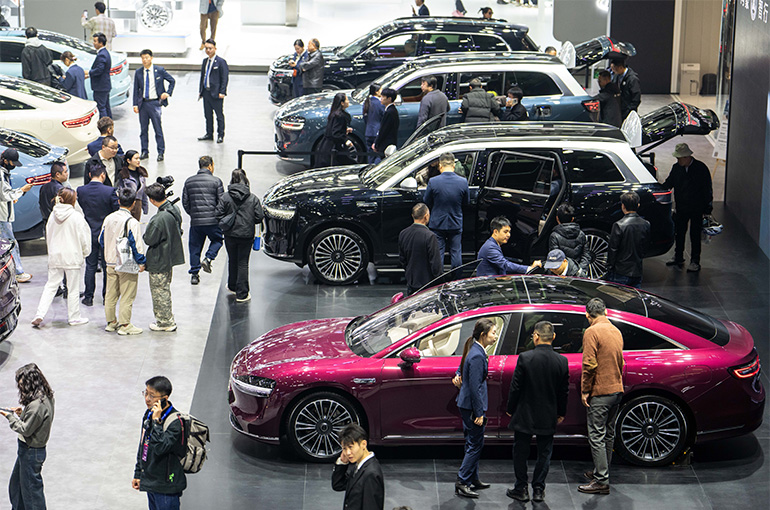 China’s Retail Car Sales Rose 5.5% in 2024; Price War Is Expected to Deepen
China’s Retail Car Sales Rose 5.5% in 2024; Price War Is Expected to Deepen(Yicai) Jan. 10 -- Retail car sales in China rose 5.5 percent last year, driven by record new energy vehicle sales and strong exports amid fierce price competition that hit carmaker profits. The price war in the world’s biggest auto market is expected to escalate even further this year.
Some 22.89 million passengers cars were sold directly to consumers in the 12 months ended Dec. 31, the China Passenger Car Association said yesterday. Wholesale sales rose 6.3 percent to 27.2 million. In December alone, retail sales jumped 12 percent to nearly 2.64 million as a result of the government’s trade-in scheme and peak buying before the upcoming Chinese New Year holiday.
Annual retail sales were about one million shy of 2017’s high point, signaling a recovery in consumer demand and highlighting the market's growth potential for this year, according to the CPCA.
Over the past two years, automakers have slashed the prices of fossil fuel, pure electric, and hybrid models to retain and gain market share, denting their earnings and those of dealers. They discounted 227 models last year, compared with 148 in 2023 and 95 in 2022. Among them, 88 were fuel cars, and 82 were electric.
NEV prices were cut by an average of 8.2 percent or CNY18,000 (USD2,455) last year, while those of fuel vehicles fell by 6.8 percent or CNY13,000. Prices dropped by an average of 8.3 percent or CNY16,000 overall.
Analysts and industry leaders predict that the price war will trigger an industry shakeout, forcing smaller or less competitive players to exit the market and reshaping China’s auto sector.
Price competition will be "extremely fierce" this year, as many carmakers push to increase their market share, CPCA Secretary-General Cui Dongshu said.
Auto firms will also come under pressure from slower export growth, which is seen declining to 10 percent this year, mainly because of Russian market saturation and additional import tariffs to Europe, Cui said.
Auto exports jumped 23 percent to 5.84 million between January and November, with Russia, Mexico, and the United Arab Emirates the main destination markets. NEV exports did well in Belgium, Brazil, the United Kingdom, and Thailand. Annual passenger car exports soared 25 percent to a record high of 4.8 million.
Retail passenger car sales are forecast to decline 20 percent this month from a year earlier because of the Lunar New Year holiday effect and demand being met early, though regional policy support and vehicle discounting will continue to buoy the market.
Shrinking Profits
In the first 11 months of last year, Chinese auto industry’s profits shrank 7.3 percent to CNY413.2 billion (USD56.36 billion), with a profit margin of 4.1 percent, below the industrial average of 6.1 percent. Revenue rose 3 percent to CNY9.46 trillion (USD1.29 trillion), while costs climbed 4 percent to CNY8.29 trillion.
The high-growth NEV market was more competitive because increased production capacity led to a reduction in costs, leaving more room for discounts.
Cui noted that despite the government's call to "counteract over-competition,” the industry's profit margin is expected to remain low in 2025, mainly due to the uneven distribution of profits, which are mostly taken by upstream suppliers, particularly battery makers.
Last year, NEV sales soared 41 percent to almost 10.9 million. That was 5 percentage points higher than in 2023. The NEV adoption rate stood at 47.6 percent, up from 35.6 percent in 2023, after exceeding 50 percent for five straight months in the second half.
BYD sold the most NEVs at over 3.7 million, a 37 percent jump, followed by Geely Automobile Group at 1.77 million, up 7.7 percent. FAW-Volkswagen was third despite its electric vehicle sales falling nearly 13 percent to 1.6 million. Changan Automobile, SAIC-Volkswagen, SAIC-GM-Wuling, Toyota Motor’s two joint ventures in China, and Tesla China ranked fourth to 10th.
China contributed about 93 percent of the growth in the global NEV passenger car market. The UK, Brazil, and the United States contributed 2 percent each, and Russia 1 percent.
China's auto production jumped 4.8 percent to 27.07 million vehicles, the CPCA’s data also showed.
Editor: Futura Costaglione